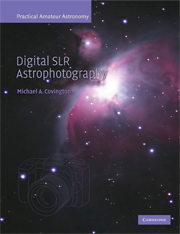Book contents
- Frontmatter
- Contents
- Preface
- Part I Basics
- Part II Cameras, lenses, and telescopes
- 5 Coupling cameras to telescopes
- 6 More about focal reducers
- 7 Lenses for piggybacking
- 8 Focusing
- 9 Tracking the stars
- 10 Power and camera control in the field
- 11 Sensors and sensor performance
- Part III Digital image processing
- Part IV Appendices
- Index
7 - Lenses for piggybacking
Published online by Cambridge University Press: 21 August 2009
- Frontmatter
- Contents
- Preface
- Part I Basics
- Part II Cameras, lenses, and telescopes
- 5 Coupling cameras to telescopes
- 6 More about focal reducers
- 7 Lenses for piggybacking
- 8 Focusing
- 9 Tracking the stars
- 10 Power and camera control in the field
- 11 Sensors and sensor performance
- Part III Digital image processing
- Part IV Appendices
- Index
Summary
Why you need another lens
You will have gathered that I think piggybacking is one of the best astronomical uses for a DSLR. But the “kit” lens that probably came with your DSLR is not very suitable for piggyback astrophotography. It has at least three disadvantages:
It is slow (about f/4 or f/5.6).
It is a zoom lens, and optical quality has been sacrificed in order to make zooming possible.
It is plastic-bodied and not very sturdy; the zoom mechanism and the autofocus mechanism are both likely to move during a long exposure.
Fortunately, you have many alternatives, some of which are quite inexpensive. One is to buy your camera maker's 50-mm f/1.8 “normal” lens; despite its low price, this is likely to be the sharpest lens they make, especially when stopped down to f/4. Another alternative is to use an inexpensive manual-focus telephoto lens from the old days. There are several ways of doing this; Nikon DSLRs take Nikon manual-focus lenses (though the autofocus and light meter don't work), and Canons accept several types of older lenses via adapters.
Big lens or small telescope?
But wait a minute–instead of a lens, should you be looking for a small telescope, perhaps an f/6 “short-tube” refractor? Some of these have ED glass or even three-element lenses and perform very well for astrophotography.
In my opinion and experience, good telephoto lenses perform even better. After all, they have more elements and more sophisticated optical designs.
- Type
- Chapter
- Information
- Digital SLR Astrophotography , pp. 70 - 88Publisher: Cambridge University PressPrint publication year: 2007



